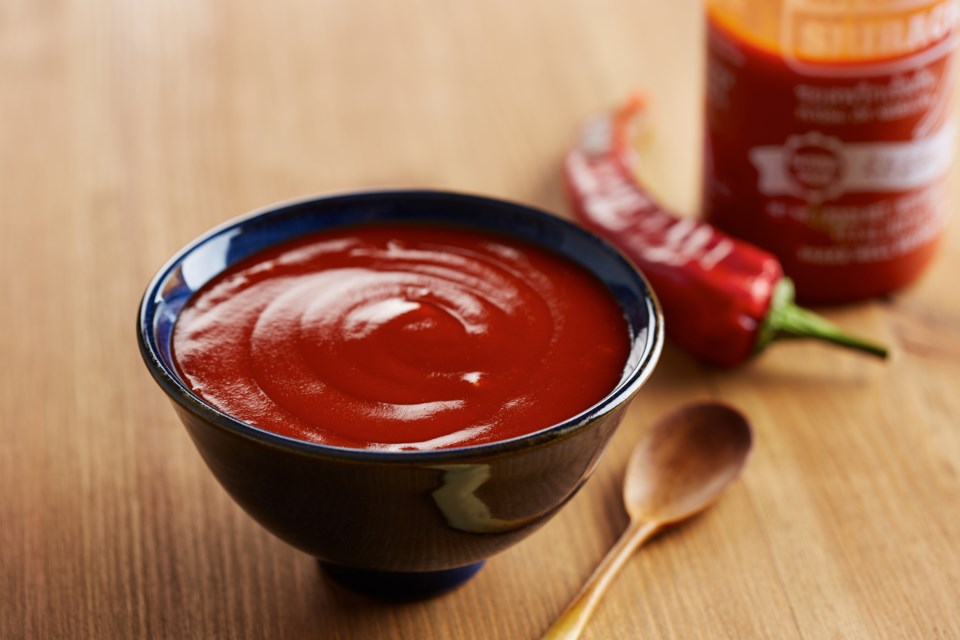For years now, the California-made Sriracha chili sauce has been cock-walking its way into the hearts and gullets of heat lovers across North America. From trendy Sunday brunch spots to hole-in-the-wall pho restaurants, you could find its instantly recognizable, green-topped bottles seemingly everywhere you went.
In recent weeks, however, the popular condiment has been virtually impossible to find.
According to Huy Fong Foods, makers of Sriracha, the lingering effects of a devastating drought in Mexico continue to stymie production, thanks to the sauce’s main, palate-firing ingredient.
“Unfortunately, we are still experiencing a shortage of raw material,” the company said in a statement last month, referring to the Mexican chili crops that have suffered due to poor weather conditions.
Huy Fong’s massive, 650,000-square-foot (60,387-square-metre) production facility in Irwindale, Calif. churns through roughly 100 million pounds (45.4 million kilograms) of the red jalapeño-hybrid chili peppers used to make Sriracha, as well as the company’s two other condiments: a chili-garlic sauce and sambal oelek.
It’s actually not the first time Sriracha lovers have had to contend with empty shelves. In July 2020, Huy Fong warned distributors of a shortage of chili peppers. Last April, the company sent an email to customers warning of an even more severe shortage, informing them they would not be accepting any new orders until September, and that customer orders placed after April would not be fulfilled until after Labour Day.
Up until 2017, Huy Fong sourced its chili peppers exclusively from a family-run farm in Ventura County, Calif., but a bitter lawsuit led to the two sides parting ways. (Huy Fong founder David Tran was forced to pay the pepper producer US$23 million for breaching its contract and committing fraud, ending a 30-year relationship.)
After the suit, Tran began sourcing the peppers from a variety of producers in Mexico, New Mexico, and California, but today, they are sourced solely from Mexico.
Though Sriracha production resumed briefly in the fall, it has since stuttered to a halt. And the bad news? There’s no end in sight, with Huy Fong offering “no estimations of when supply will increase.”
The shortage has turned Sriracha prices online downright absurd. A quick scan of Amazon shows a standard 28-ounce, rooster-adorned bottle currently starts at about $50. Inexplicably, there is also a box of 50 small Sriracha packets, like you’d find in the bottom of your Chinese takeout bag, listed for—wait for it—$2,200 on Amazon. (This is where I offer up the half bottle of Sriracha still sitting in Pique’s office fridge to the highest bidder. Support your local newspaper and all that.)
So, what’s a Sriracha-obsessed hothead to do without their favourite spicy condiment? Well, funnily enough, while there is a shortage of the real deal, you won’t struggle to find a knockoff out there—some even have “Sriracha” listed on the bottle. While Huy Fong’s iconic rooster and green cap are trademarked, the U.S. Patent and Trademark Office considers Sriracha a general term.
The best in that category, for my money, is Bushwick Kitchen’s Weak Knees Gojuchang Sriracha sauce, made from many of the same ingredients as its more popular cousin, except with the epic sweet-savoury-spicy flavour bomb of Gojuchang, Korea’s ubiquitous chili paste, thrown in.
As far as similar-but-not-quite Sriracha alternatives, you can’t go wrong with the aforementioned sambal oelek, an Indonesian-originated chili sauce or paste that is typically thicker and spicier than Sriracha, with a hint of bitterness. It works as both a condiment and a marinade, and, in fact, when cooking with sambal oelek, it tastes as close as you can get to using fresh chilies. What’s more is, because it’s a relatively simple recipe using mostly crushed raw chilies, vinegar and salt (although there are dozens and dozens of variations), it’s easy enough to make at home, meaning you don’t have to rely on Huy Fong to get your fix.
A personal favourite of mine, and a staple at Chinese restaurants, is chili crisp oil, or Xi膩ng là cuì, a type of hot sauce made with fried chili pepper, some form of aromatic such as garlic, scallion or onion, and drenched in oil. Containing crispy bits of chili pepper, it is heavy on the crunch, and more of an oil than a sauce consistency. Practically every Chinese restaurant and chef worth their salt (er, chili flakes) has their own version of chili crisp oil, and most are tightlipped about the ingredients. The best I’ve ever had is at Chinatown BBQ in Vancouver, a simple, no-fuss place in the heart of Chinatown that is a throwback to the Cantonese barbecue joints of old, replete with glistening, crispy duck hanging on hooks in the window. I offered to buy some once but they flatly refused, instead sending me on my way with a full container of the stuff for free, probably because they felt bad for not telling me what was in it.
If you’re not up for a trip to the city, Chinese brand Lao Gan Ma makes a great version of its chili crisp oil, which can be found in most grocery stores.




